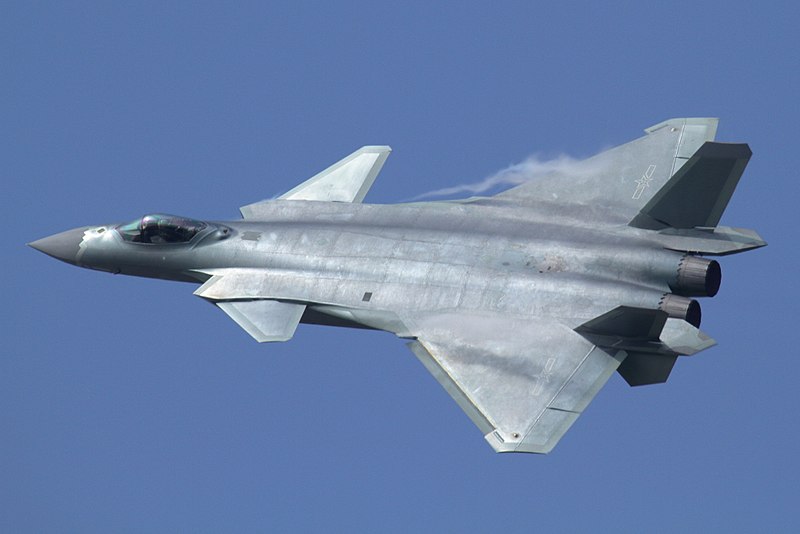China flying its fifth-gen J-20 stealth fighter jets in the largest-ever formation during the CPC centenary celebrations was aimed at asserting Beijing’s growing air power.
The airshow was also intended to draw the attention of potential foreign customers to Chinese jets.
China, the world’s second-largest military spender, is slowly moving ahead in the race of becoming a global exporter, according to the latest data by Stockholm International Peace Research Institute (SIPRI).
China was the fifth largest arms exporter in the world in the last decade (2010 to 2020) – behind the United States, Russia, France, and Germany, moving from ninth-largest during the 2005-2009 assessment.
China As An Arms Exporter
According to SIPRI’s assessment, a major share of exports was consumed by Asia (77.3%) followed by Africa (19.1%) and the remaining 3.6 percent went to other parts of the world including Latin America.
The top customers for Chinese arms in Asia include Pakistan, Bangladesh, and Myanmar. In Africa, countries like Algeria, Tanzania, Nigeria remain top importers of Chinese arms.
The export market has gone up from 40 to 53 countries in the latter half of the decade and four of the country’s defense companies feature in the top 25 of the world.
China has benefited largely from the trick of filling the gaps as many of its arms markets faced sanctions by the West.
- At €7.8B, Why Indian Rafale Jets Are ‘Double The Cost’ Than Egyptian Rafales?
- Why Did Netizens ‘Mock’ Nigeria For JF-17 Deal With Pakistan?
Countries like Venezuela, on which the US placed an arms embargo for failing to cooperate with US-led anti-terrorism efforts, Pakistan which faces similar international sanctions, and Iran, an arch-rival of the U.S-led allies who faced an arms embargo for the last 13 years over its nuclear program have shifted towards Chinese military hardware.

China also signed a $400 billion Strategic Cooperation Agreement with Iran that will define and guide the cooperation between the two for the next 25 years.
The use of Chinese arms and other equipment by state and non-state actors in conflict-ridden countries especially in the Middle East region has been repeatedly criticized by international experts.
Export of Chinese Jets
China’s most powerful J-20 ‘Mighty Dragon’ fighter jet reportedly faces an export ban due to fears of “fifth-generation technology going to hostile hands”.
It is similar to the export curbs placed on the US F-22 Raptor, one of the two stealth fifth-generation jets that the US operates, the other being the F-35.
The National Interest quoted Song Zhongping, a former officer in Beijing, on the possibility of China considering lifting the ban only if the US does so. “If America’s allies possessed F-22s, China’s allies would need J-20s to balance them,” Zhongping had said.
Shenyang Aircraft Corp (SAC), a self-funded private company considered the “cradle” Chinese fighter jets, has successfully developed combat aircraft since Mao’s era.
During the Cold War era, the J-5, J-6 and J-7, the Chinese variant of Soviet MiG-17, MiG-19 and MiG-21 fighters, put China’s fighters on the global map. The buyers included Pakistan, Vietnam, Albania, Egypt, Iran, Myanmar, Nigeria and even the United States which reportedly purchased J-5 (NATO name Fresco) to use as mobile threats in testing.
It is believed that North Korea still operates F-5 (the export version of J-5) and F-6 (a domestic variant of J-6). The later versions of Shenyang aircraft — J-8, J-11 (developed from Russian Sukhoi Su-27) and J-16 — are exclusively used by the Chinese PLA Air Force. It remains unclear whether these models were produced for export purposes or not.
The development of an air superiority fighter aircraft J-13 was even canceled.
On the other hand, jets developed by Chengdu Aircraft Industry Group (CAIG) such as Chengdu J-7 and JF-17 Thunder have been exported to Bangladesh, Pakistan, Myanmar and Nigeria.
China is reportedly marketing its fourth-generation multi-role fighter jet Chengdu J-10, which competes with the US F-16, but there are no takers yet. Iran might be on the table but China seems reluctant to strike a deal, as reported by The Eurasian Times.
Forbes published an article comparing the growth of the Chinese jet industry with the Russian and predicted the possibility of China potentially exporting more fighters as more markets will shift towards China for aircraft equipment.
In addition to China’s manufacturing capacity, use of composite materials to keep the jet lightweight, integration of Active Electronically Scanned Array (AESA) radars into modern designs and a more mature stealth system makes China surpass the Russian aircraft designs, the article noted.
China has replaced Russia in the number of combat jets in service, according to the World Air Force’s 2021 directory.
FC-31, an advanced fifth-generation stealth fighter jet developed by SAC, is supposedly an answer to the US F-35, eyeing global markets.
A prototype of China’s FC-31 stealth fighter jet was reportedly on public display during the 70th founding anniversary of Shenyang Aircraft Corp (SAC), indicating a milestone in the aircraft’s development.
Limited Buyers?
Despite an ambitious indigenous fighter jet program, Chinese jets have limited buyers. Richard Aboulafia, an expert on aircraft and aerospace, opined in Foreign Policy that China is struggling to woo buyers for its advanced combat military aircraft.
Citing data from SIPRI, the article said that in the last decade, China exported $7.2 billion worth of military aircraft, most of which include individual components and not the jet itself. It places the country behind the US ($99.6 billion), Russia ($61.5 billion) and France ($14.7 billion).
Targeting China’s foreign policy, Aboulafia noted that China’s lack of commercial soft power and strategic alliances has pushed away its potential customers like Malaysia and the Philippines while the dominant military markets Singapore, South Korea, Australia remain aligned with the US.
However, as the CPC enters a new era, pledging to expand “China’s military and influence”, the question remains whether the country can emerge as a mass exporter of fighter jets.
Read More